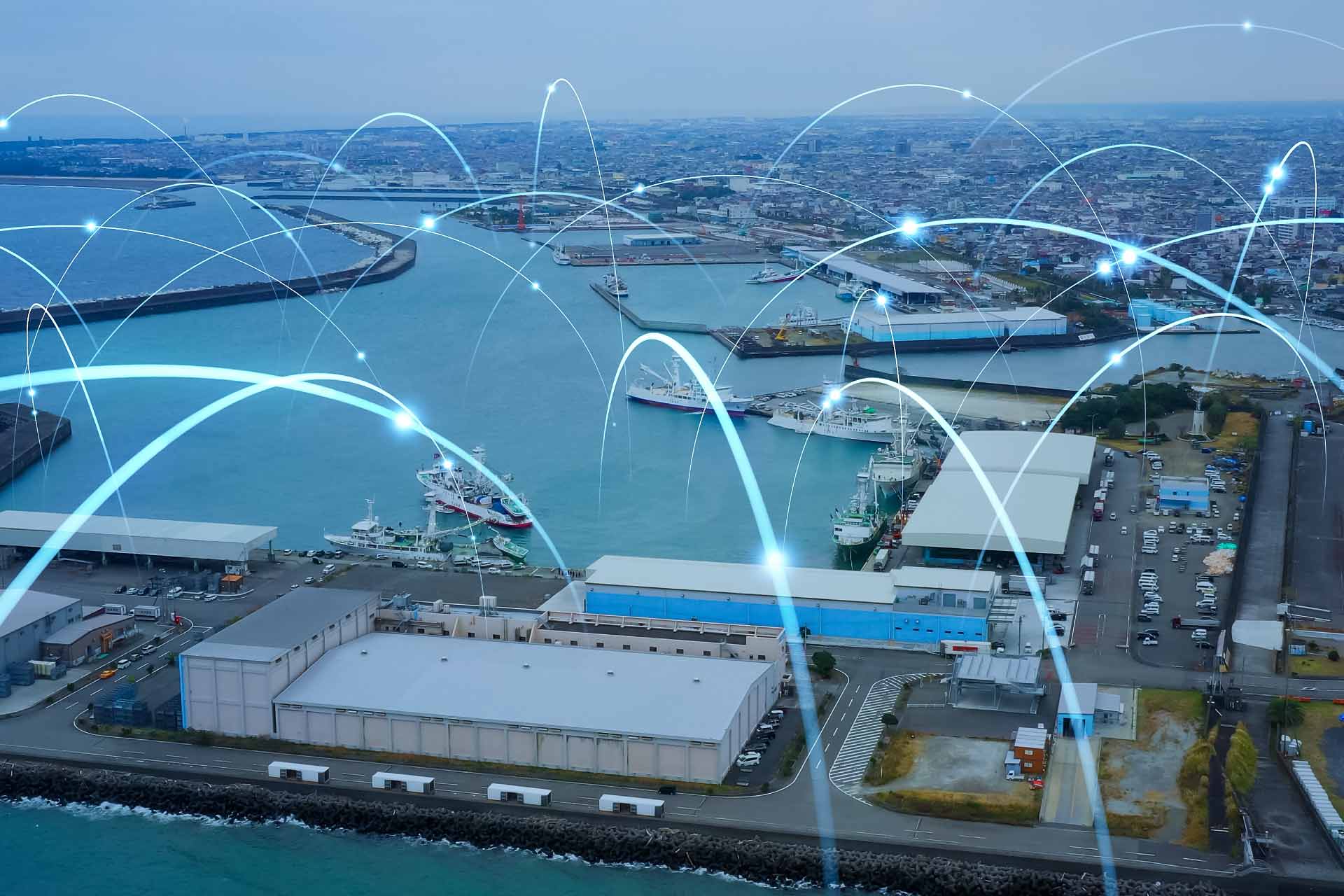
Dr Cagatay Iris’ investigation looks into the pathways and associated challenges of port, shipping and logistics decarbonisation, and identifies the priority initiatives to take a leap forward for a green shipping corridor in the Irish Sea.
In a joint research project involving British and Northern Irish universities, industry partners and innovation agencies, Cagatay and colleagues have defined a feasible roadmap to decarbonisation in the Liverpool-Belfast corridor, with potential to be rapidly initiated for regular sailings.
The results, summarised in the Liverpool-Belfast Green Shipping Corridor (2024) report, explain the technical and policy changes needed to establish a green shipping corridor between the two cities and regions.
The report also identifies 29 suitable pilot projects to develop the corridor further and secure a leading international role in green ports and shipping for the UK.
As well as the potential to scale up and catalyse the energy transition in similar maritime operations, the project presents opportunities for expansion into the hinterlands and port-rail connections with other cities.
Urgent need for action to reduce emissions in the maritime sector
In Liverpool and Northern Ireland alone, maritime transportation generates nearly 14,000 direct jobs and contributes almost £5bn per year to the UK economy.
However, the shipping sector’s financial impact comes with an important environmental cost, as it is responsible for around 3% of global greenhouse gas (GHG) emissions.
Shipping emissions have accelerated in recent years, and with maritime transportation expected to grow, we could see a 50% increase in GHG emissions by 2050, relative to 2018 levels1.
The urgent need for action is demonstrated by international initiatives to achieve net zero carbon emissions by the mid-century.
In line with the Paris Agreement, the International Maritime Organisation2 seeks to reduce shipping GHG emissions by 100% by 2050, with a global shift away from fossil fuels by 2030.
In the UK, the Sixth Carbon Budget sets strict limitations3 and for the first time includes the national share of international shipping GHG emissions, increasing pressure on the maritime sector to decarbonise.
Defining a feasible roadmap to maritime decarbonisation
In a move to develop practical solutions, the Clydebank Declaration – signed by 24 nations at COP 26 – set the commitment to establish six green shipping corridors by 2026.
A green corridor is a maritime route between two or more ports, aimed to support the transition to zero emissions, through the route and at port facilities.
The concept involves all initiatives deployed to lower the environmental impact of domestic and international trade, when vessels are stationary (berthed) and sailing.
With the full value chain4 approaching barriers to decarbonisation together, green corridors help break down existing silos and develop collective solutions.
Green corridors present challenges in several areas, from energy supply and land-based logistics to regulation and safety implications, plus commercial viability.
To provide realistic solutions, Cagatay is working as part of a research consortium involving Connected Places Catapult5, Royal HaskoningDHV6, Mersey Maritime7, the University of Liverpool, Queen’s University Belfast and Liverpool John Moores University.
The project aims to kickstart the Irish Sea green shipping corridor and inspire collaboration with local authorities, shipping lines, port authorities, investors, regulators and energy providers.
Bringing the green corridor to life
Although vessels use energy when they are berthed and sailing, the latter is typically responsible for the highest GHG and air pollutant emissions.
Operating a fully electric vessel in the Irish Sea can be challenging beyond short distances, due to, for example, energy storage constraints and available in-port charging facilities.
Low-carbon liquid fuels might be a suitable alternative to diesel, but the most efficient, safe and cost-effective option must be identified8.
Based on stakeholder preferences and a technical review of available energy sources, methanol and shore green power emerged as the preferred potential options, but this requires infrastructural changes at both ends of the corridor.
While methanol is emerging as industry-preferred, it needs 2.3 times the volume of fuel compared to marine diesel, thus new in-port operational procedures and storage tanks are needed to safely handle this fuel.
Alternatively, the existing supply pipe networks could be modified to transfer methanol from nearby production sites, with the most suitable candidates being Liverpool’s Stanlow Terminals9 and/or HyNet10, and Port of Larne11 in Belfast.
A significant investment in the National Grid would also be necessary to increase electrical capacity, either via new Energy System Operator (ESO) substations12 at ports or by improving connections with existing ones13.
Changes in terminal infrastructure are also required to support new shore power systems and facilitate energy independence.
This may include new quayside structures, alongside high-voltage cable networks and on-site renewable energy facilities.
But technical solutions are not the only issue, as stakeholder collaboration holds the key to low carbon sea freight.
The report includes several recommendations for government leaders to address ecosystem barriers:
- Stricter environmental legislation, policies and strategies to support and enforce decarbonisation, ideally aligning with EU policies
- Subsidies and incentives for shore power installations and to reduce the cost of alternative fuels and electricity
- Commitment to public-private co-investment in green maritime
- Support to close local skills gaps for the green shipping corridor
- A single management board to oversee the regional green shipping transition and future direction of the corridor.
Where to start?
The report also sets up a future course of action, with a series of practical initiatives for asset owners, operators, investors and government to engage with.
Following a rigorous assessment and stakeholder feedback from 29 pilot projects developed in collaboration with industry representatives, several pilot projects emerged as priority first steps.
The ‘Incentivised commercial model for shore power investment’ project, seeks to design a bespoke commercial model for investment in shore power, so faster infrastructure and vessel investments are attracted.
The goal is to appeal to private investors with financially attractive options, such as leasing, construction and electricity subsidies, etc, to provide capital.
‘Shore power implementation at one berth’ is a project that focuses on direct carbon savings from berthed electrification and aims to test the feasibility of providing shore power to one single berth before scaling up.
The idea is to build an onshore power supply berth at Victoria Terminal 2 (Belfast) or 12 Quays (Birkenhead), and quantify carbon savings, fuel reduction, GHG emissions, air quality improvement and demand spikes, alongside learning from the construction process.
The ‘Irish Sea energy simulation model for electricity/alternative fuel demand’ project aims to evaluate and forecast the economic feasibility of supply chain options for electricity and alternative fuels use, to guide capital investment.
The project estimates future energy demand and considers available energy sourcing and generating opportunities in the Irish Sea and the wider region.
‘Trial production of e-methanol and methanol diesel blends as marine fuel’ focuses on testing the production of these fuels, using offshore wind energy and feed/waste fuels14.
Finally, ‘Energy management system for ports’, focuses on delivering smart energy management frameworks to create extra capacity and reduce power waste, through a smart meter and sub-station monitoring installation.
1 According to the International Maritime Organisation’s Fourth Greenhouse Gas Study 2020, shipping related emissions increased nearly 10% between 2012 and 2018.
2 The International Maritime Organisation is the United Nation’s Global Maritime Regulator, to reduce emissions in the maritime sector as per the Paris Agreement 2016.
3 The UK’s Sixth Carbon Budget sets limits on the volume of GHG emitted over a five-year period between 2033-37 to take the UK three-quarters of the way to reaching net zero by 2050.
4 The value chain refers to all the business activities involved in creating a service.
5 Connected Places Catapult is the UK’s innovation accelerator for cities, transport and place leadership.
6 Royal HaskoningDHV is a consulting engineering company specialised in climate change, digital transformation and energy transition.
7 Mersey Maritime is the regional cluster organisation for the maritime industry and wider supply chain in the Liverpool City Region and the greater Northwest.
8 Low-carbon liquid fuels present their own challenges. Due to lower energy densities, larger volumes of these fuels are required for the same journey compared to diesel. A larger challenge is the sourcing and supply of new fuels to vessels within regional geography, either via local generation or transport from fuel hubs.
9 Stanlow Terminals in Ellesmere Port (Cheshire) is developing the UK’s first CO2 import terminal, essential in the production of e-methanol.
10 HyNet North West is a low carbon and hydrogen energy project aimed at reducing CO2 emissions from industry and support economic growth in the North West of England and North Wales.
11 Port of Larne is part of the Power-to-X Project aimed at facilitating the use of green methanol as a scalable zero emission fuel for maritime industry. The plans include developing facilities to synthesise e-methanol at the port.
12 In Liverpool, this would include building a new ESO substation near the port and additional high-voltage distribution within Seaforth Dock, supplied by renewable energy.
13 In Belfast, this might involve laying a new high-voltage cable across Belfast City to establish additional connections with existing ESO substations at a 5km distance.
14 Feed/waste fuels are made from organic matter, such as food waste, animal manure and wastewater.
 |
Senior Lecturer in Operations and Supply Chain Management |